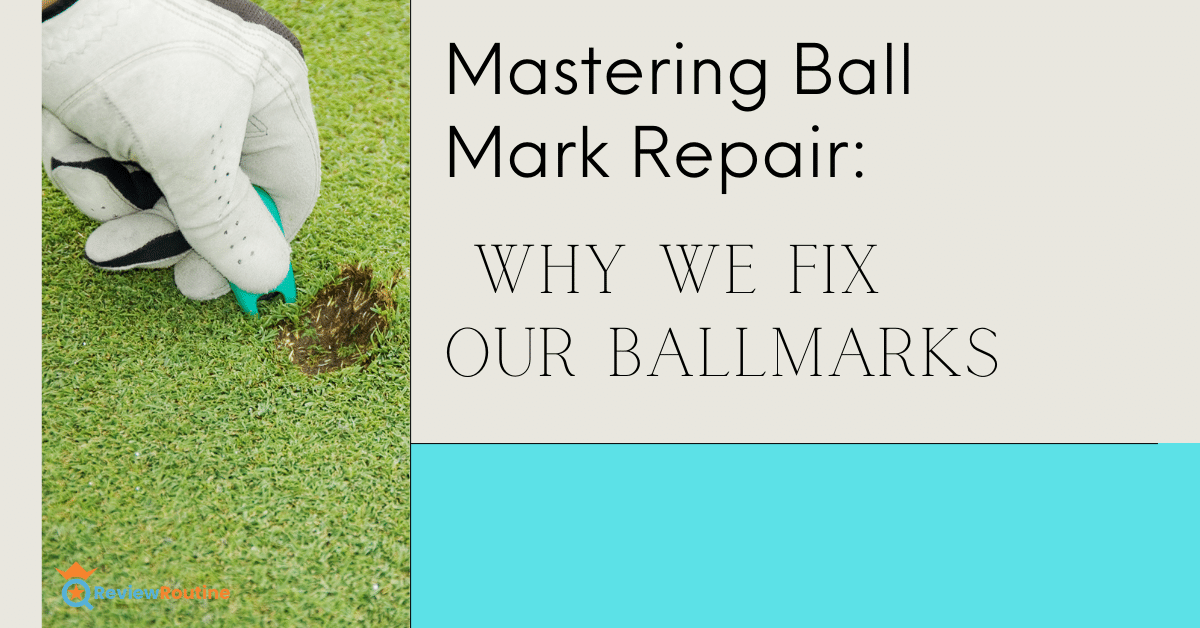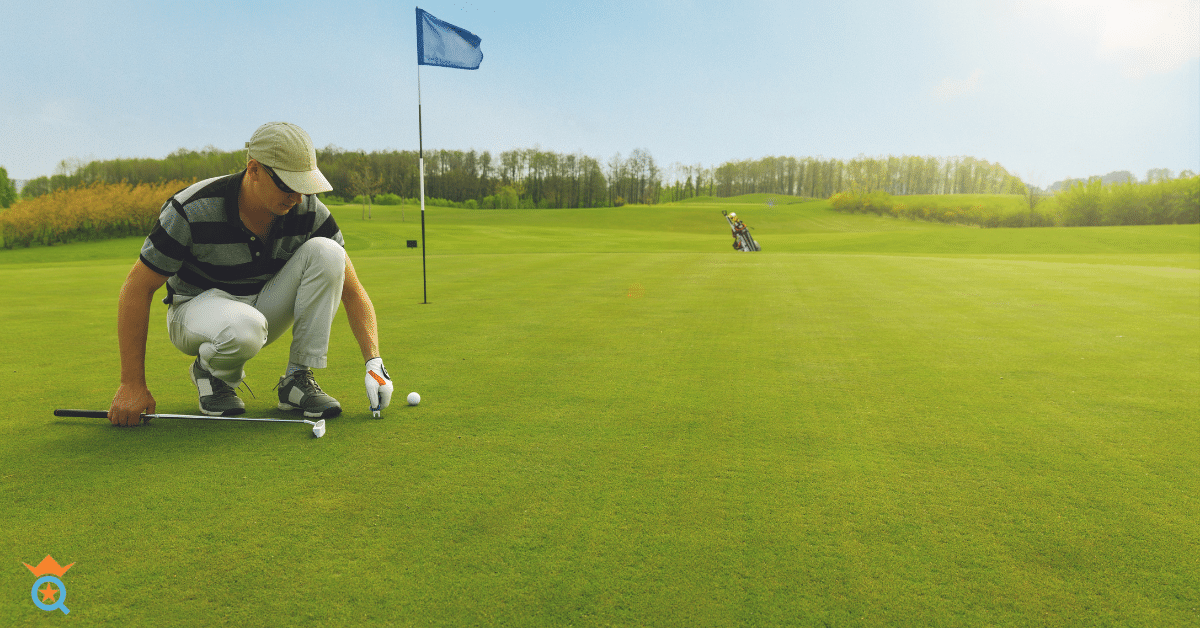If you're someone who takes their golf game seriously, then you know how important it is to keep the course in top shape. And one of the simplest yet most effective ways to do that is by fixing those pesky ball marks.
In this guide, we'll be breaking down everything you need to know about repairing ball marks, from the proper techniques to the best tools for the job.

So, whether you're a seasoned pro or a newbie to the game, let's dive in and become masters of ball-mark repair!
Why We Fix Our Ball Marks
So, why do we bother fixing ball marks? Well, there are a few great reasons!
First, it helps preserve the putting surface quality, making sure our shots roll smoothly. Second, it ensures optimal playing conditions, so everyone can enjoy a top-notch golf experience. Lastly, it's all about good sportsmanship and showing respect for fellow golfers.
When we leave ball marks unrepaired, it affects the whole golfing experience. Nobody wants to play on a bumpy putting surface or a poorly maintained golf course, right? So, let's do our part and fix those ball marks to keep our courses in great shape!

Vulnerable Putting Greens
Certain putting greens are more vulnerable to ball marks than others. For example, greens that receive high, lofted shots, like those on par-3 holes, are often more susceptible to damage.
That's why it's extra important for us golfers to be attentive and proactive when playing on these greens.
To help protect these vulnerable greens, we can make a habit of repairing not just our ball marks, but also any others we spot nearby.
By being more mindful and diligent in fixing ball marks, we're doing our part to keep these sensitive greens in great condition for everyone to enjoy.

The Role of Course Conditions in Ball Mark Formation
Soft course conditions and increased ball marks go hand in hand. When the greens are wet or soft, ball marks tend to be more of an issue.
That's why golf course superintendents work hard to maintain firm playing conditions, reducing the chances of ball marks forming in the first place.
These dedicated professionals use various techniques, like aeration and topdressing, to keep the greens in top shape. By doing so, they help minimize ball mark problems and ensure our golf courses remain beautiful and enjoyable for everyone who loves the game.
Lasting Problems Caused by Unrepaired Ball Marks
Not fixing ball marks can lead to some pretty annoying long-term consequences. For starters, it takes much longer for the greens to heal, and we might even end up with weeds making themselves at home in those spots. Yikes!
And it's not just about the course itself; it also affects our fellow golfers who have to deal with uneven putting surfaces.
Plus, let's not forget the hardworking maintenance teams who have to put in extra time and effort to fix the damage. So, by repairing our ball marks, we're helping everyone enjoy a better golf experience and keeping those lasting problems at bay.
Tools and Techniques for Effective Ball Mark Repair
When it comes to repairing ball marks, there are a few tools and techniques to keep in mind to make sure you're doing it right. Here are some tips:
- Ball mark repair tool: These tools come in various shapes and sizes, but they all have a pointed end to help lift the indentation. Place the tool behind the ball mark and gently push the top of the tool toward the center. Continue working around the ball mark, pushing the surrounding turf toward the center of the indentation.
- Golf tees: If you don't have a repair tool handy, a golf tee can work in a pinch. Insert the tee into the edge of the ball mark at a 45-degree angle and use a gentle twisting motion to lift the turf.
- Avoid lifting or twisting motions: It's important to avoid lifting or twisting the turf, as this can damage the turf roots and make the problem worse. Instead, focus on pushing the surrounding turf toward the center of the ball mark.
By using the right tools and techniques, you can repair ball marks effectively without causing any further damage to the course.

The Importance of Fixing Ball Marks: Enhancing Golf Course Conditions and Experiences
When it comes to enjoying a great round of golf, the condition of the course plays a huge role in our overall experience. One small but crucial aspect of maintaining a top-notch golf course is repairing ball marks. Taking a moment to fix these marks not only preserves the quality of the putting surface but also promotes fair play and sportsmanship among golfers.
By understanding the importance of fixing ball marks, we can all contribute to enhancing golf course conditions and ensuring a fantastic experience for everyone on the green.
1. Preserving Putting Surface Quality
Repairing ball marks is super important for keeping putting smooth surface and consistent. If we don't fix them, it messes with ball roll and accuracy, which isn't fun for anyone. So, next time you're out on the course, be sure to repair those marks and help make the game enjoyable for everyone. Remember, a little effort goes a long way in maintaining a great golfing experience for all players!
2. Promoting Fair Play and Sportsmanship
Speaking of making the game enjoyable, fixing ball marks is also about promoting fair play and sportsmanship. As golfers, we share a responsibility to keep the course in tip-top shape for others. When we repair ball marks, we're helping to create a level playing field and a positive experience for everyone. So, the next time you step onto the green, just remember that your small act of repairing ball marks contributes to the bigger picture of sportsmanship and fair play.
3. Preventing Long-term Damage to Greens
Now, let's talk about the long-term damage that can happen if we don't fix those ball marks. Unrepaired marks take much longer to heal and might even let pesky weeds sneak in. Nobody wants that! Plus, it means more work for the maintenance crew to get things back in shape. So, by taking a few seconds to repair your ball mark, you're helping to prevent lasting damage to the greens and making life easier for the hardworking folks who keep our courses beautiful.
4. Protecting Vulnerable Putting Greens
Let's not forget about those vulnerable greens that are more prone to ball marks. Greens that receive high, lofted shots, like par-3 holes, tend to be more susceptible to damage. When playing on these greens, it's super important for us golfers to be extra mindful of repairing not just our ball marks, but also any others we spot nearby. This way, we're doing our part to protect those sensitive greens and ensure a great playing experience for everyone who follows.
5. Ensuring Optimal Playing Conditions
Do you know what's awesome? Playing on a well-maintained golf course. Repairing ball marks plays a big part in that! When we fix those marks, we're contributing to the overall quality of the course. And, since course conditions can impact ball mark formation, we must stay consistent with our maintenance efforts. This way, we can all enjoy a top-notch golfing experience.
6. Demonstrating Proper Golf Etiquette
Fixing ball marks isn't just about keeping the course in great shape; it's also a matter of proper golf etiquette. When we repair ball marks, we're showing respect for the game, the course, and our fellow players. So, let's lead by example and educate other golfers on the importance of fixing those marks. Together, we can create a golfing community that values respect and sportsmanship.
Bonus Tip: Fill Your Divots
When repairing a golf ball mark on the green, it's important to remember that tee boxes and fairways need some TLC too. After taking a divot, be sure to fill it up with the supplied sand or replace the original trench. This not only helps the ball mark restore the grass but also speeds up the healing process for the area. Plus, nobody wants to trip in a ditch on their way to the next shot!
Filling divots is an essential etiquette regulation that can earn you some serious karma from the golf gods. It's all about showing respect for the course and the other players who will be following in your footsteps. And if you're looking for more etiquette tips, be sure to check out our list for a comprehensive guide to properly repair divot holes.
Popularity of the Game
The Bottom Line
Repairing a ball mark is a crucial task for responsible golfers who care about maintaining optimal course conditions and promoting good sportsmanship. A repaired ball mark not only restores the putting surface to its smooth and consistent state but also helps to prevent long-term damage to the turf.
Remember, unrepaired ball marks are not just a scar on the green, but a potential hazard for future shots. So let's all take the time to repair a ball mark properly, and avoid causing any further damage to the course.
By doing so, we can all enjoy a more enjoyable and fulfilling golfing experience, both for ourselves and our fellow players.








